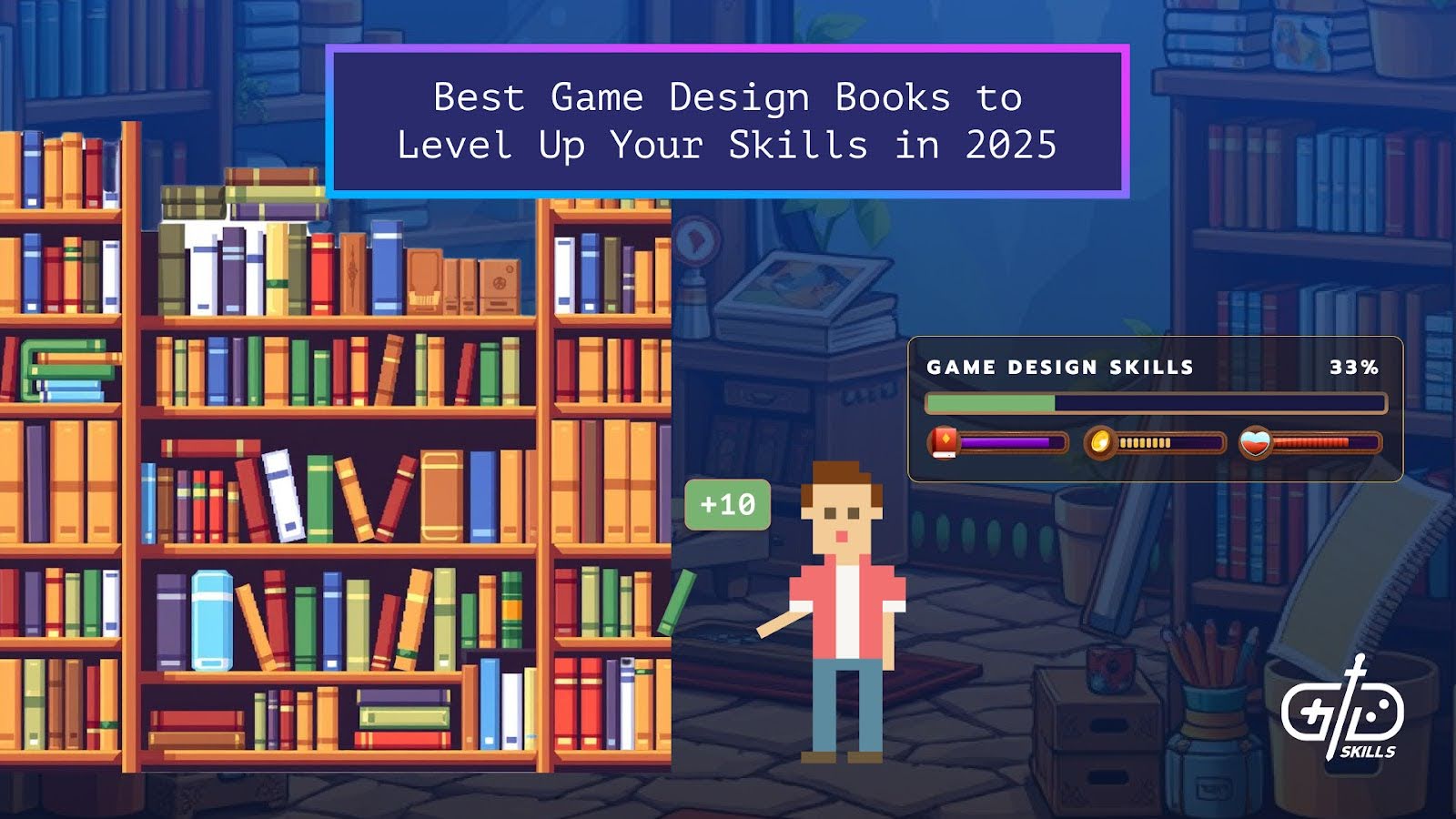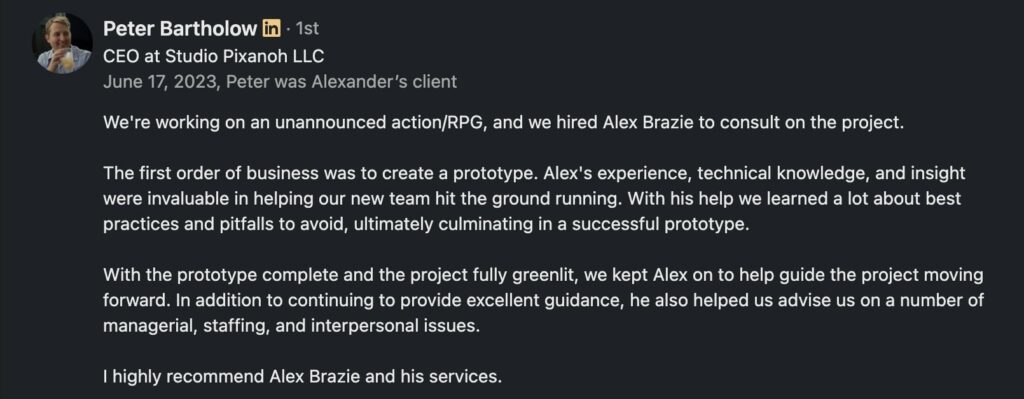Game design books are reference materials that offer insights from veteran game designers of various schools of thought about their habits, workflows, techniques, and processes that any game designer should absorb and practice. Books teach essential skills such as narrative design, game balancing, perfecting game feel, creating a hook, advanced game design, and so on. Read on, pick a book, and start learning with these 24 practical and highly acclaimed game design books.
1. The Role of a Great Game Designer
The Role of a Great Game Designer is a book by industry veteran Richard Carillo, who has worked with studios like EA, Ubisoft, KAOS Studios, and Sledgehammer Games. Richard’s work focuses on providing practical insights and clarifying common misconceptions about the game designer role. The book shows a more complete definition of the role, the skills it requires, and the expectations teams should have for it.
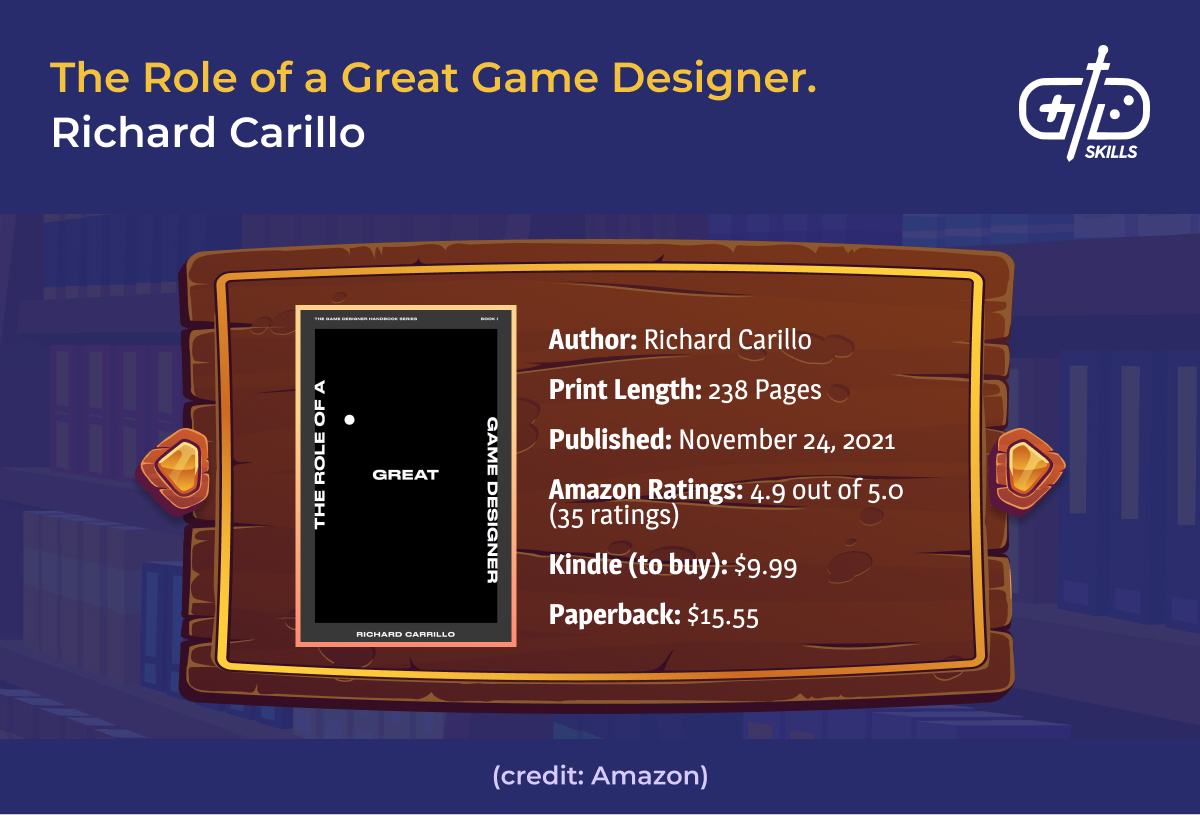
Carillo’s book clearly outlines an actionable framework for the game design process from vision to final product. It touches on the necessary technical and interpersonal skills to work with a team to build and enhance a game designer’s knowledge and confidence in the field. It turns the creative process into a disciplined one, allowing the designer to bring their innovative ideas to life within a development team and help it succeed despite the ever-changing industry trends.
2. Narrative Design for Indies: Getting Started
Narrative Design for Indies: Getting Started by Edwin McRae is a book about designing games around a smaller team and budget, making it an essential pick for aspiring independent game designers. It’s authored by veteran narrative lead Edwin McRae, known for the tactical card game Flesh and Blood by Legend Story Studios.
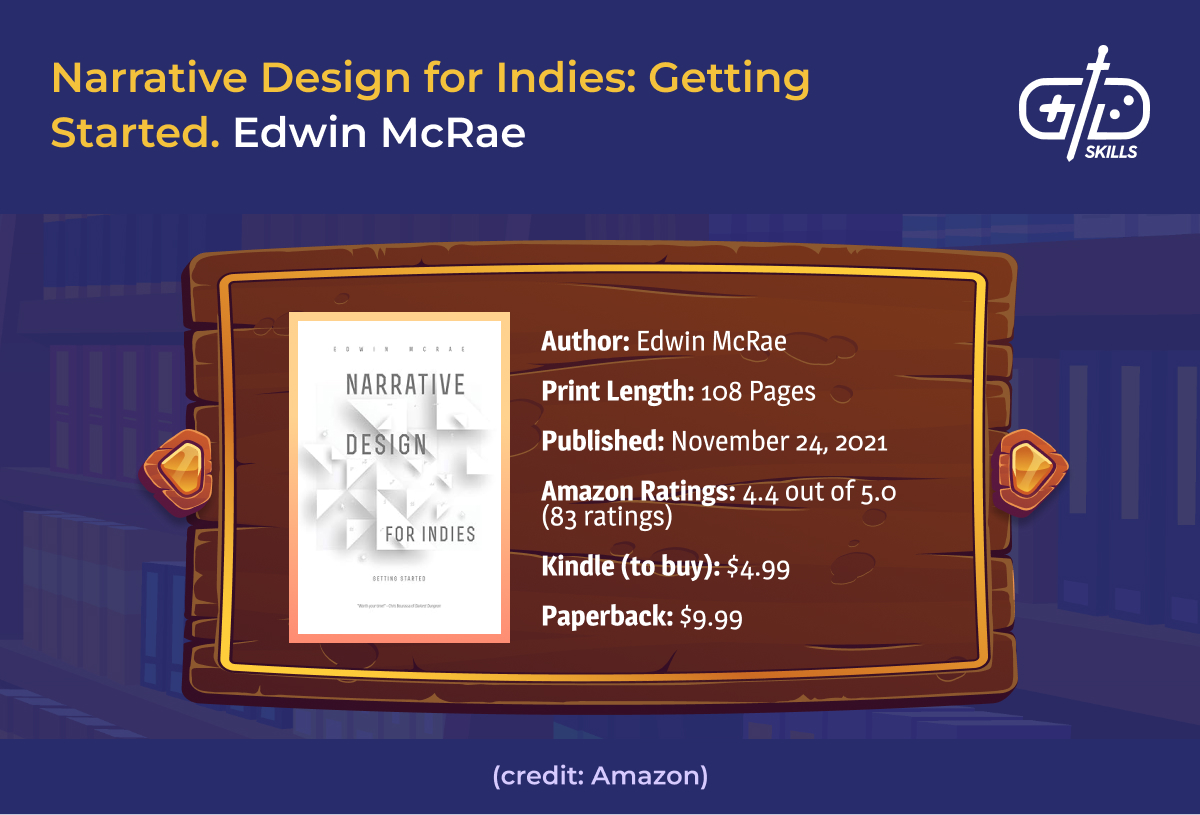
McRae’s work offers a unique perspective on storytelling or narrative in games that shift away from traditional narrative structures often seen in AAA titles. The book is tailored for designers looking to dip their toes into independent game design or already working in the indie scene. McRae changes the reader’s design perspective by giving designers the tools and mindset to create engaging narratives that fit the limits of independent development while still creating innovative and amazing game experiences.
3. Game Design Workshop: A Playcentric Approach to Creating Innovative Games
Game Design Workshop: A Playcentric Approach to Creating Innovative Games emphasizes the importance of player experience and meeting the needs of the target audience. Writer Tracy Fullerton has worked on the game Walden, an literary exploration of author and naturalist Henry David Thoreau’s time at Walden pond in the late 19th Century. The book is currently on its fourth edition and is full of Fullerton’s insights on player-centric design techniques.
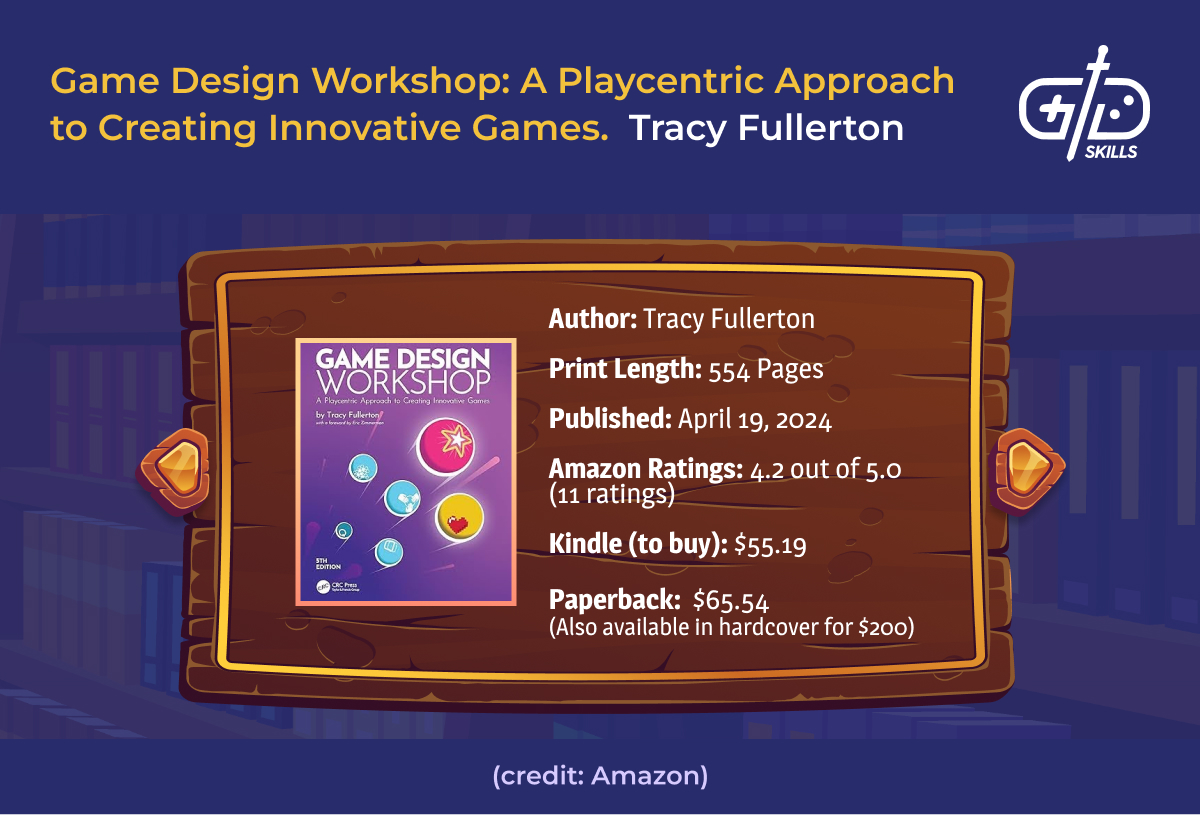
Game Design Workshop: A Playcentric Approach to Creating Innovative Games goes beyond abstract tips and advice. As the name suggests, this is a workshop complete with hands-on methods and practical exercises that demonstrate how to put ideas into action. The focus is on player-first design and is based on the USC Interactive Media and Games Division coursework. Additional contributors to Game Design Workshop include Warren Spector, Keita Takahashi, and Eric Zimmerman.
4. Designing Games: A Guide to Engineering Experiences
Designing Games: A Guide to Engineering Experiences focuses on applying an engineering approach to game design. Writer Tynan Sylvester is the designer/developer behind the beloved sci-fi colony sim, Rimworld, and founder of Ludeon Studios. The book covers the relationship between game mechanics and player emotions, exploring options for merging narrative with interactivity in a seamless way.
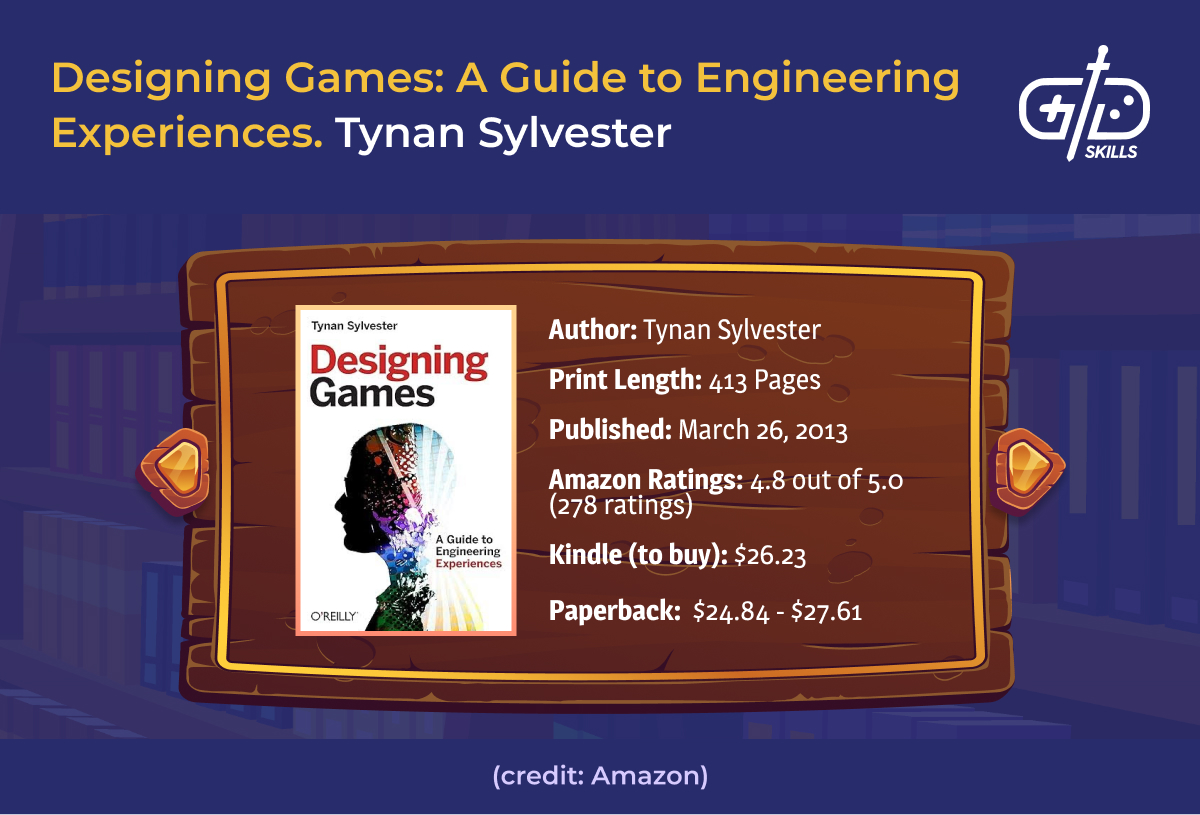
Designing Games: A Guide to Engineering Experiences details the day-to-day practices that keep the game development cycle on track. Sylvester leverages his experience to give advice on practical frameworks for designing mechanics, systems, and rewards that align with the rest of a game’s identity. The books’s exploration of the intersection between narrative and interactivity is an interesting read for both aspiring and veteran game designers.
5. An Architectural Approach to Level Design
An Architectural Approach to Level Design explores how incorporating architectural and spatial design principles into game design improves functionality and immersion of game spaces. Author Christopher W. Totten is a game developer and a trained architect. He uses his unique perspective to offer insights into how and why humans interact with certain spaces in specific ways. He merges these principles with those of game design to help designers create spaces that players are eager to explore and interact with.
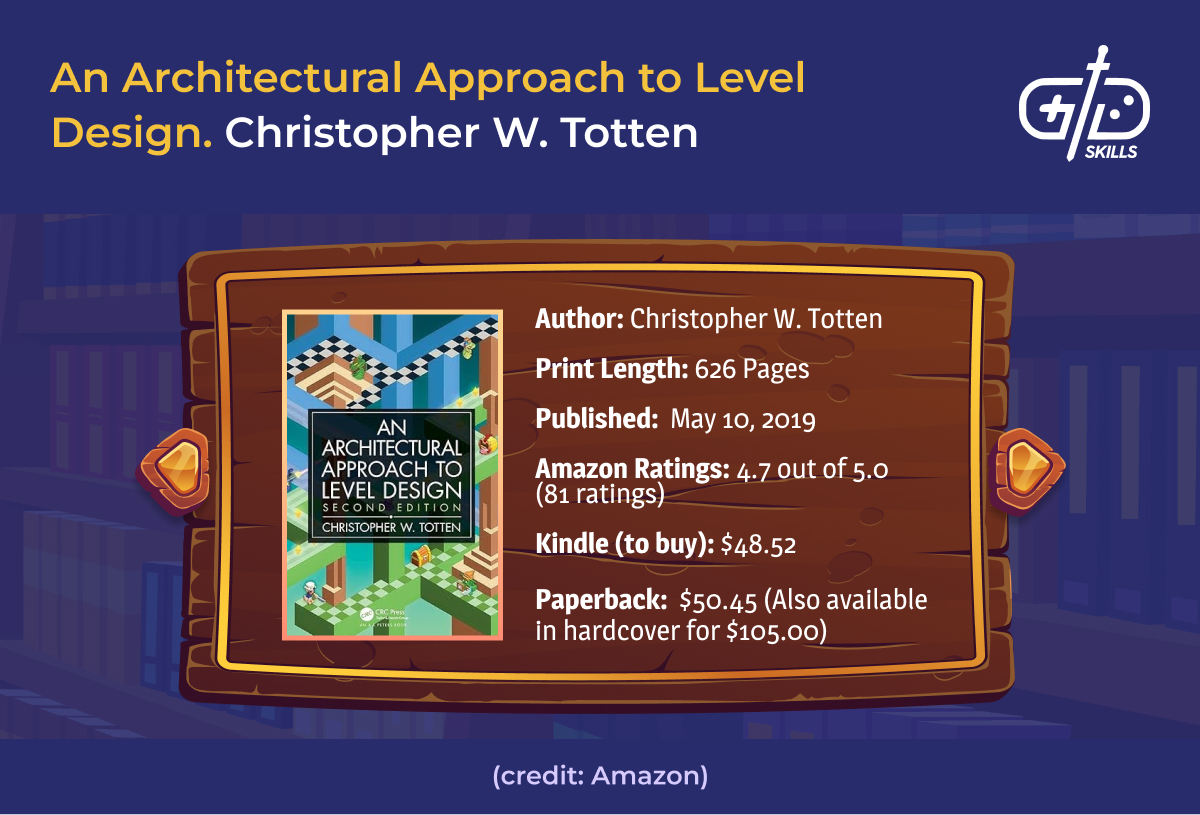
The book’s 2nd edition uses architectural theory to explore game spaces, discussing how specific spaces evoke certain emotions and encourage certain actions. These concepts help designers move past intuitive “do it because it feels right” design and into a more deliberate use of space to guide the players’ experience. The architectural methodology becomes a structured game design technique that readers apply to their own creation.
6. Game Balance
Game Balance is co-authored by influential game designers Ian Schreiber and Brenda Romero (formerly Brathwaite). The book offers their shared extensive experience with game design and provides valuable insight into the most challenging and elusive aspects of game development. The book helps readers realize and understand the big picture of balancing. The topics learned in the book make the game feel fair while considering impacts on player experience, strategy, and longevity.
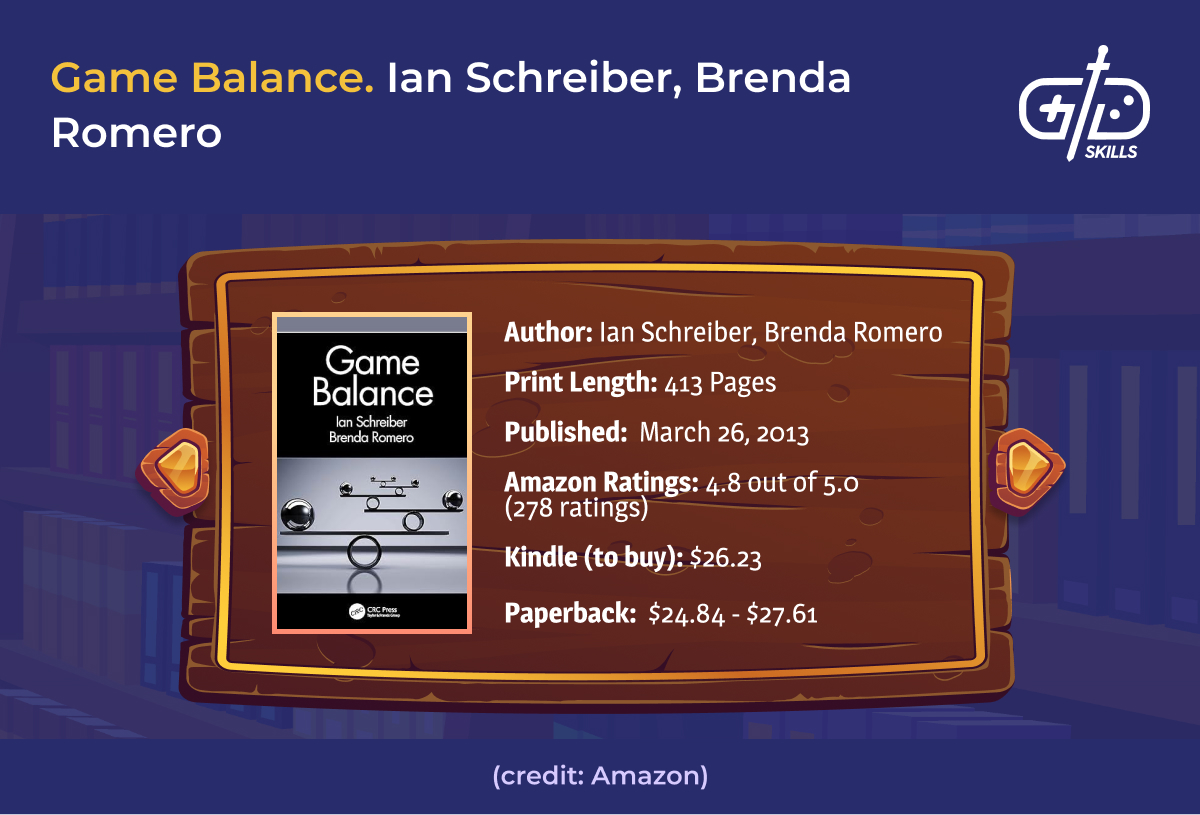
Schreiber and Romero’s work is the first and only book to explore game balance as a topic in-depth, covering topics ranging from intermediate to advanced while making it accessible to novice students of game design to understand and apply. The book contains powerful and tested spreadsheet techniques accompanied by short-form exercises at the end of each chapter, allowing readers to practice the techniques discussed. The book features three long-term projects, each divided into parts, that involve their creation.
7. The Art of Game Design: A Book of Lenses
The Art of Game Design: A Book of Lenses presents different ‘lenses’ for viewing a game’s design and mechanics and describes the deepest and most fundamental principles of game design. Authored by acclaimed game designer, educator, and author Jesse Schell, His 3rd edition of the book adds noteworthy examples of VR and AR platforms as well as modern AAA games, F2P games, hybrid games, transformational games, and more.
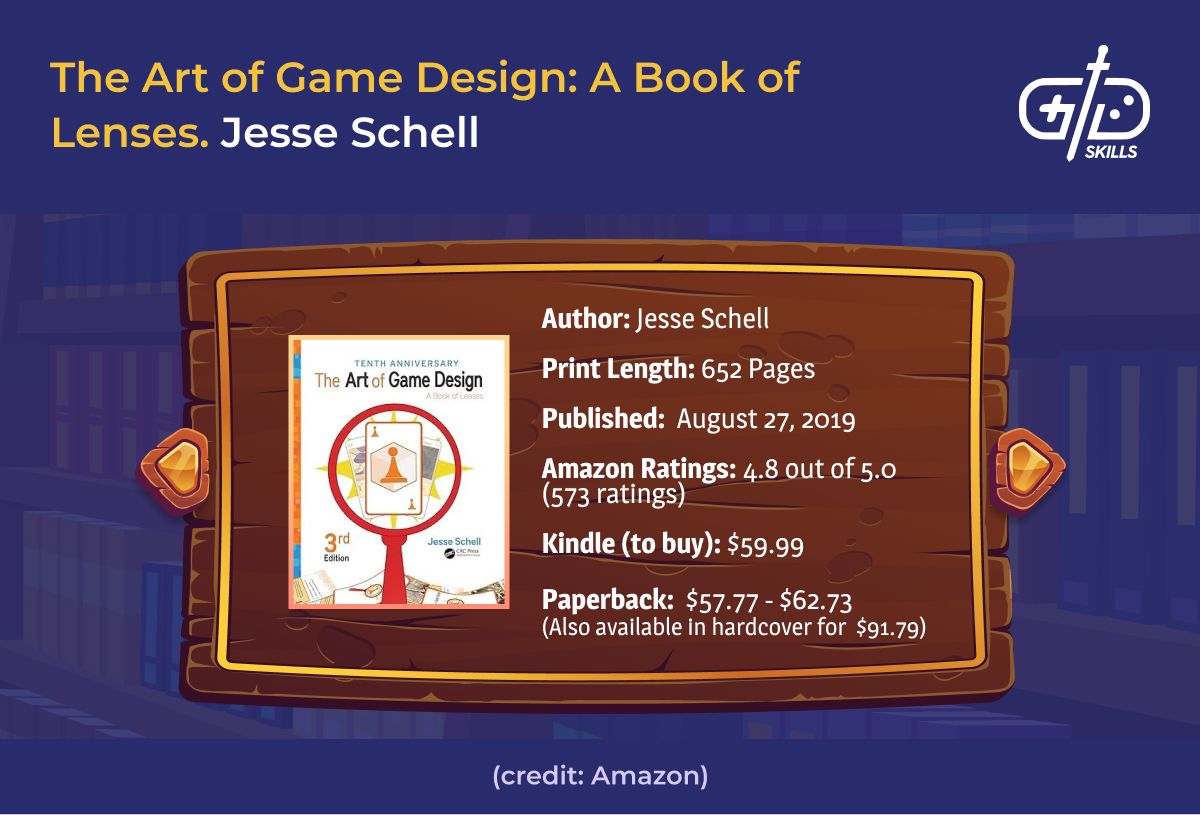
The book is an easy-to-digest toolbox for continuous learning and problem-solving. It introduces the “lenses” framework, which gives 100 distinct, short, intriguing perspectives that encourage the game designer to view their game or a specific problem from a particular angle. It hones and empowers game designers’ skills by allowing them to systematically analyze, critique, and innovate their creations.
8. Narrative Design for Writers: An Industry Guide to Writing for Video Games
Narrative Design for Writers: An Industry Guide to Writing for Video Games is another book from Edwin McRae that aims to turn the reader’s talent for writing into a narrative design career in the games industry by fundamentally reorienting their knowledge and understanding of storytelling in an interactive medium.
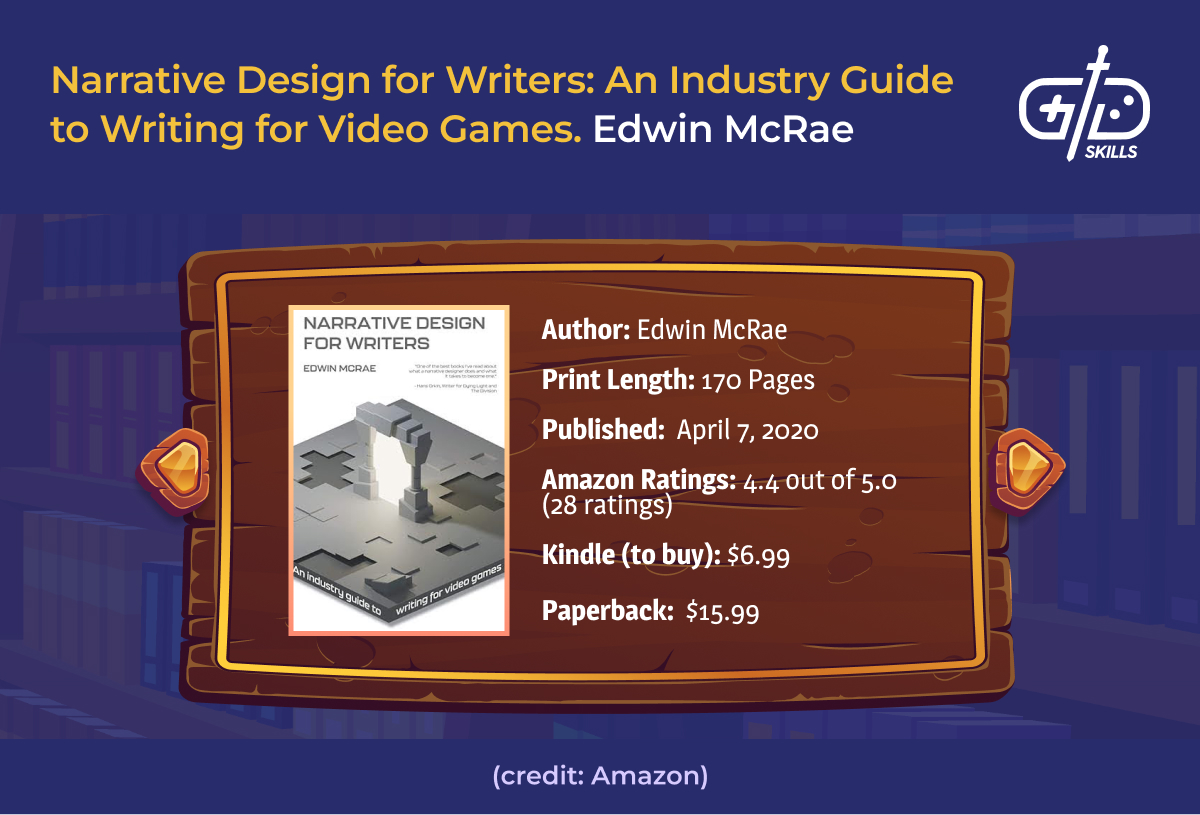
McRae’s book shows the difference between a great story and a great game story, wherein one is told and the other is experienced. It emphasizes why video game narratives need a different design approach to writing, and it shows how traditional scriptwriting, storylining, poetic, copywriting, and prose-producing skills can be applied to video game narrative creation.
9. Game Feel
Game Feel looks to articulate the concept of “feel” in video games, a term used to describe the meta-sensation of interacting with a digital environment. Writer Steve Swink is a notable designer and developer who’s worked at studios like Insomniac Games and Midway. Game Feel consolidates existing theories on game feel and introduces Swink’s own concepts and explanations.
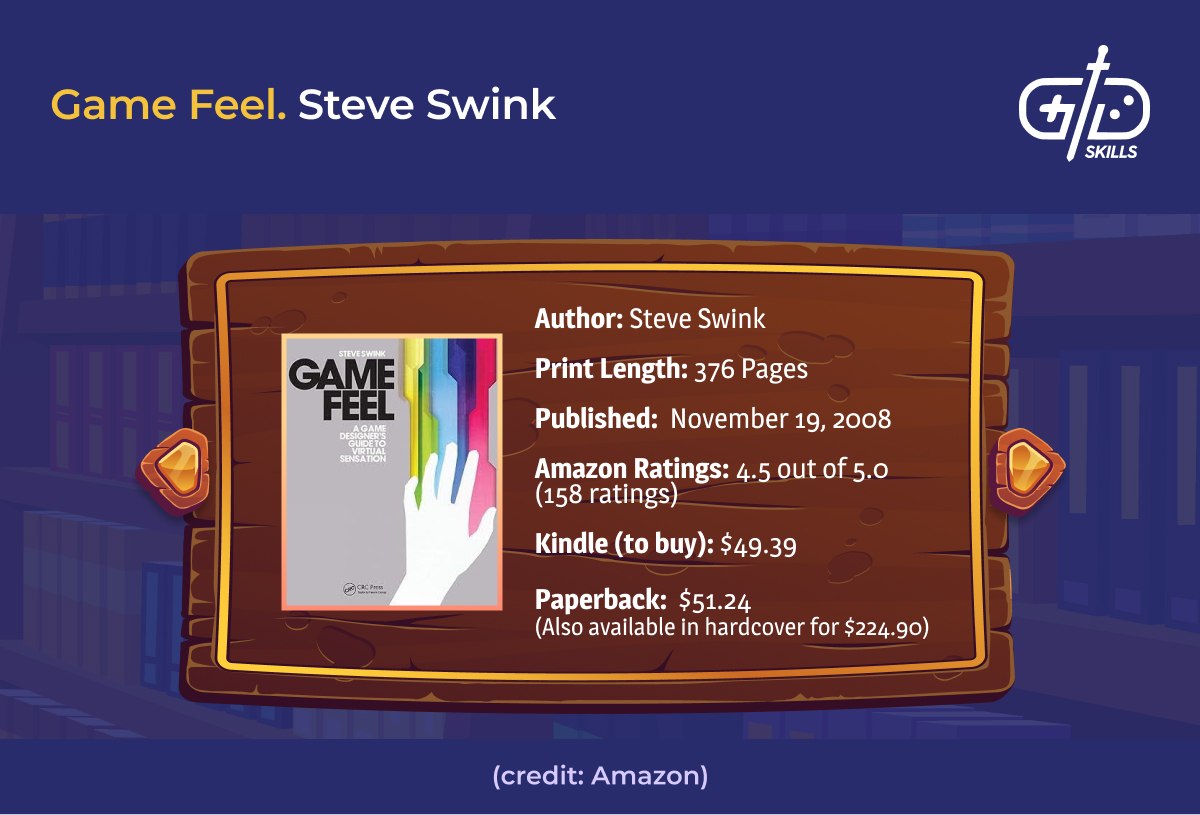
Swink provides a framework for understanding the elements that contribute to “feel” in a video game. Sound, ancillary indicators, and the role of metaphor and prior experience on player perception of “feel” are analayzed. Purchasing Game Feel gives readers access to an associated website with a set of tools and playset for designing and refining game feel.
10. Hooked: How to Build Habit-Forming Products
Hooked: How to Build Habit-Forming Products looks at game design from a customer psychology perspective to create habit-forming gameplay experiences. Writer Nir Eyal is a consultant working at the intersection of psychology, tech, and business. In Hooked, he explains the the 4-step “hook” model that many successful companies use to create recurring customers.
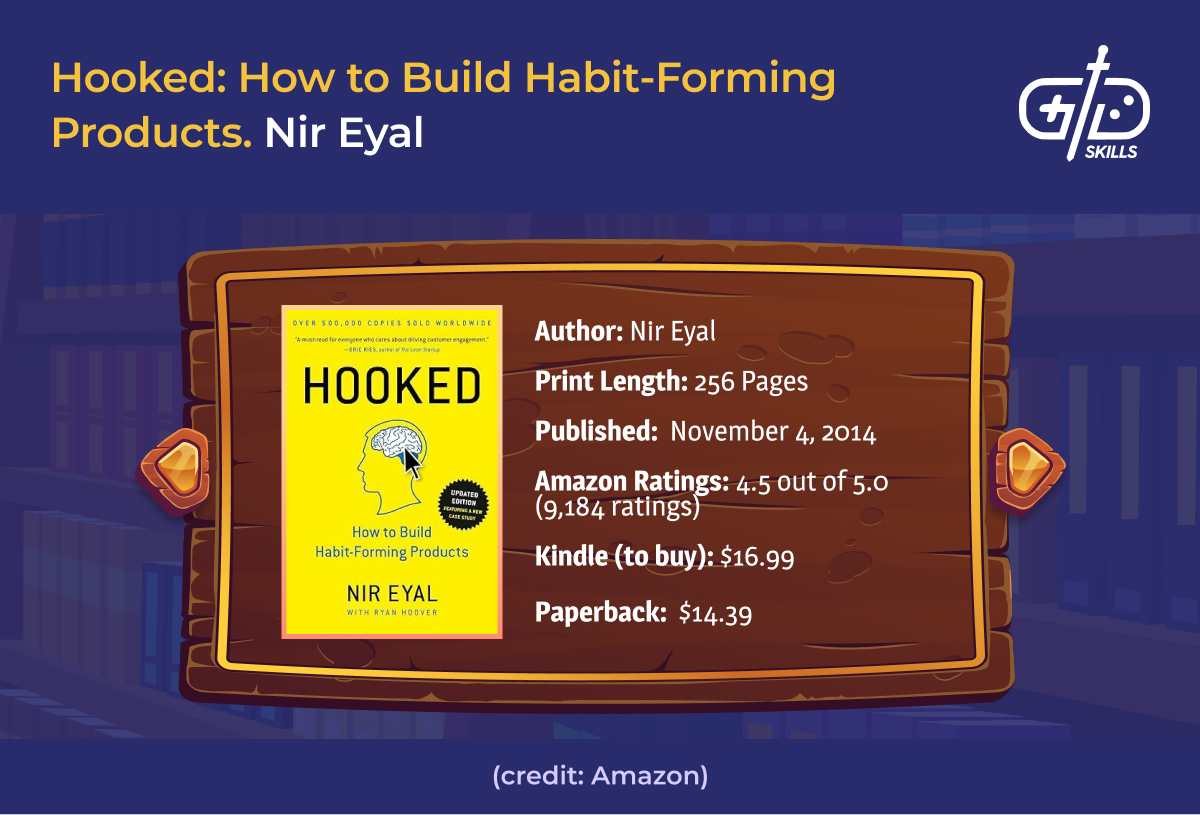
Hooked is not specifically a game design book, but explains how “hook cycles” create returning customers without aggressive advertising – useful information for game design. Eyal covers insights on turning customer habits into repeated patterns using examples from tech products like iPhone, Twitter, and Pinterest. Hooked offers psychological insights that have guided human desires for millenia, and then explores how well-designed technology products tap into those desires.
11. The Gamer’s Brain: How Neuroscience and UX Can Impact Video Game Design
The Gamer’s Brain: How Neuroscience and UX Can Impact Video Game Design applies scientific knowledge to video game UX design. Author Celia Hodent is UX expert with a PhD in psychology and has worked with companies such as Epic Games, Ubisoft, and LucasArts. Hodent offers insights into how human capabilities and limitations influence our perceptions, and how this knowledge applies to video game UX design.
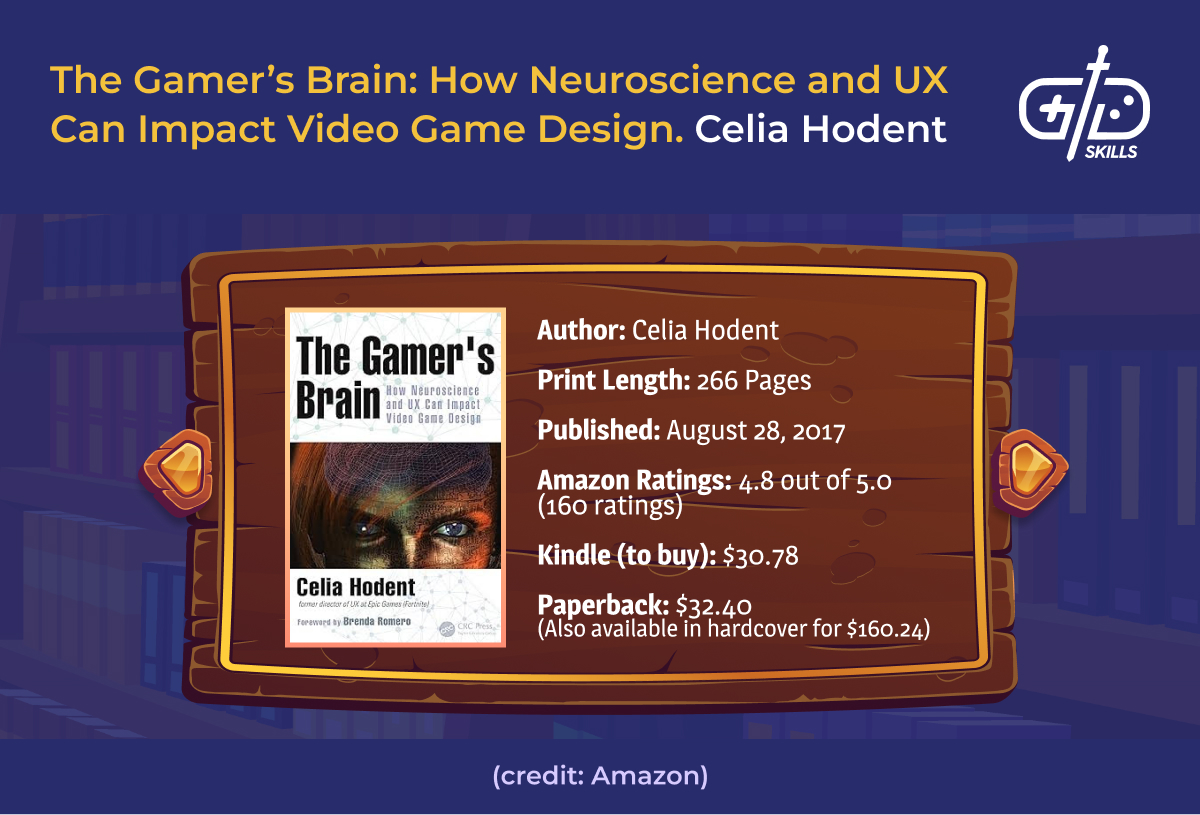
The Gamer’s Brain explores how concepts from cognitive science and neuroscience inform game UX design, and offers readers tips on how to apply these principles to make more intuitive, engaging experiences. Hodent discusses how the human brain processes information, and how these processes guide our decisions and interactions. By applying these insights, designers develop a framework for designing UX, rather than relying on instinct.
12. The Gamification of Learning and Instruction Fieldbook: Ideas into Practice
The Gamification of Learning and Instruction Fieldbook: Ideas into Practice looks is a follow up to Karl M. Kapp’s book, The Gamification of Learning and Instruction. In the fieldbook, Kapp, Lucas Blair, and Rich Mesch offer tips, analysis, and worksheets for creating, engaging, interactive learning experiences. The fieldbook appeals primarily to educators, but features insights that apply to creating engagement regardless of genre or platform.
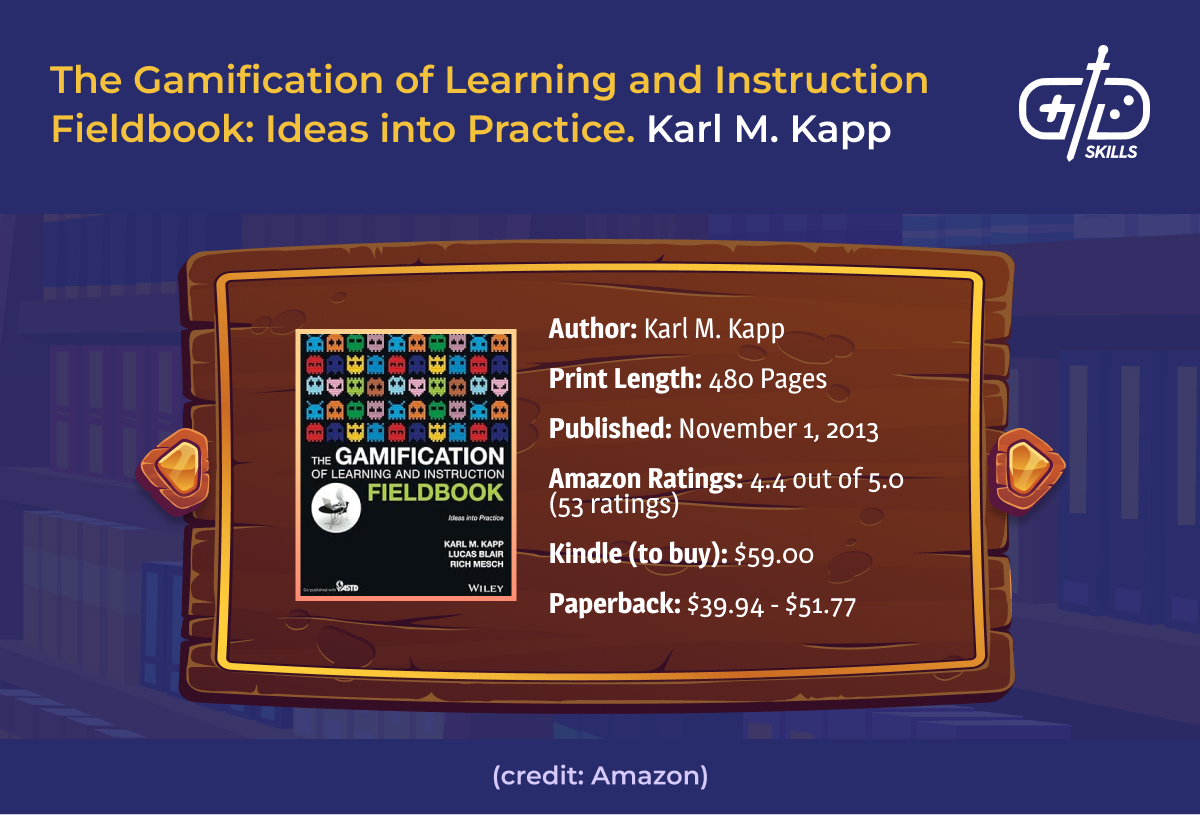
Kapp’s previous work was an examination of theories underpinning the gamification process. The fieldbook is a practical workshop, with worksheets, case studies, and provocative questions that help designers create engaging learning experiences. Its authors cover topics like mechanics, dynamics, and behavioral nudges that designers use to drive specific actions in players.
13. Challenges for Games Designers: Non-Digital Exercises for Video Game Designers
Challenges for Games Designers: Non-Digital Exercises for Video Game Designers is a book that’s designed to challenge readers, improve their brainstorming abilities, and most of all, sharpen their game design skills. This book is authored by award-winning game designer Brenda Romero, who has worked on iconic games such as Wizardry, Jagged Alliance, and Def Jam.
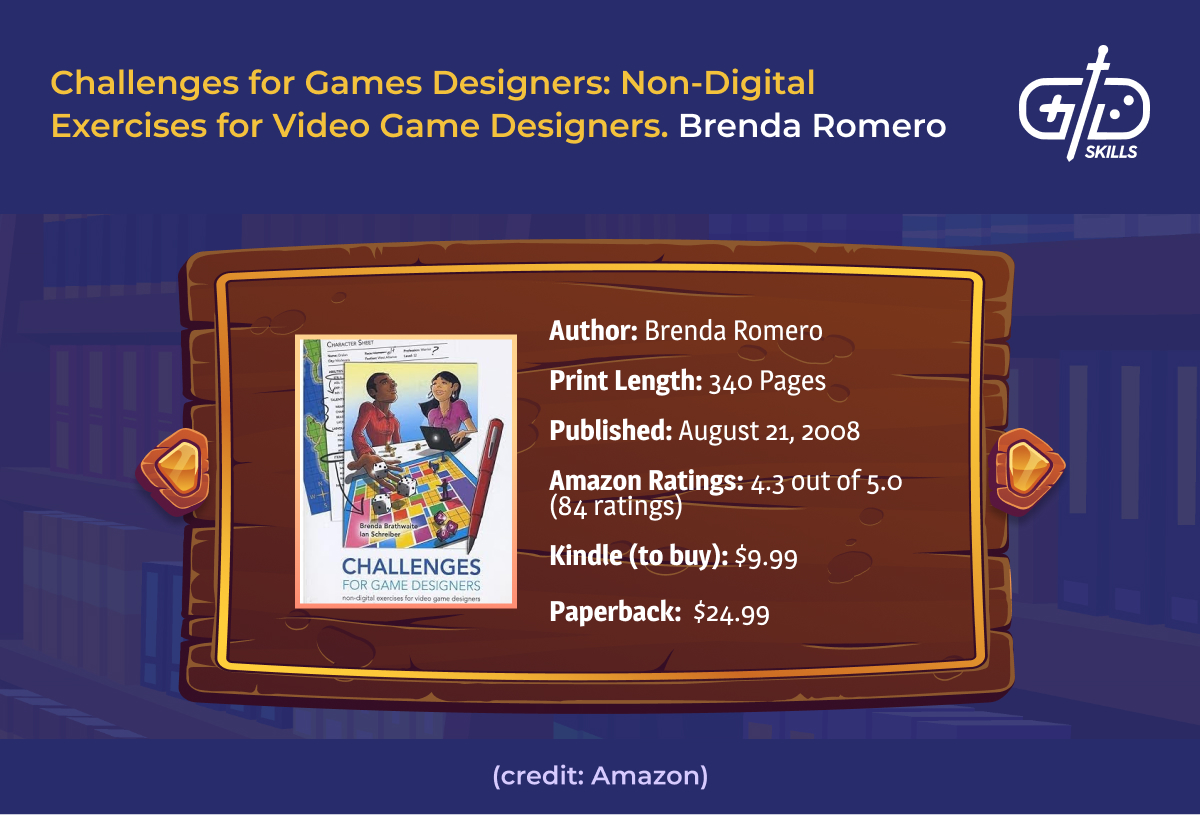
The book has enjoyable, thought-provoking, yet challenging exercises for both professionals and aspiring game designers. Each chapter covers various topics that impart knowledge from Romero’s industry experience and has five challenges at the end of each to help readers apply the material, explore further, and be the best game designers they can be.
14. Introduction to Game Design, Prototyping, and Development: From Concept to Playable Game with Unity and C#
Introduction to Game Design, Prototyping, and Development: From Concept to Playable Game with Unity and C# is a book by award-winning professor and game designer Jeremy Gibson Bond. The 3rd edition of the book melds game design, prototyping, and development together in a single book, and fully integrates these elements to help readers master the practice of iterative prototyping using the Unity game engine.
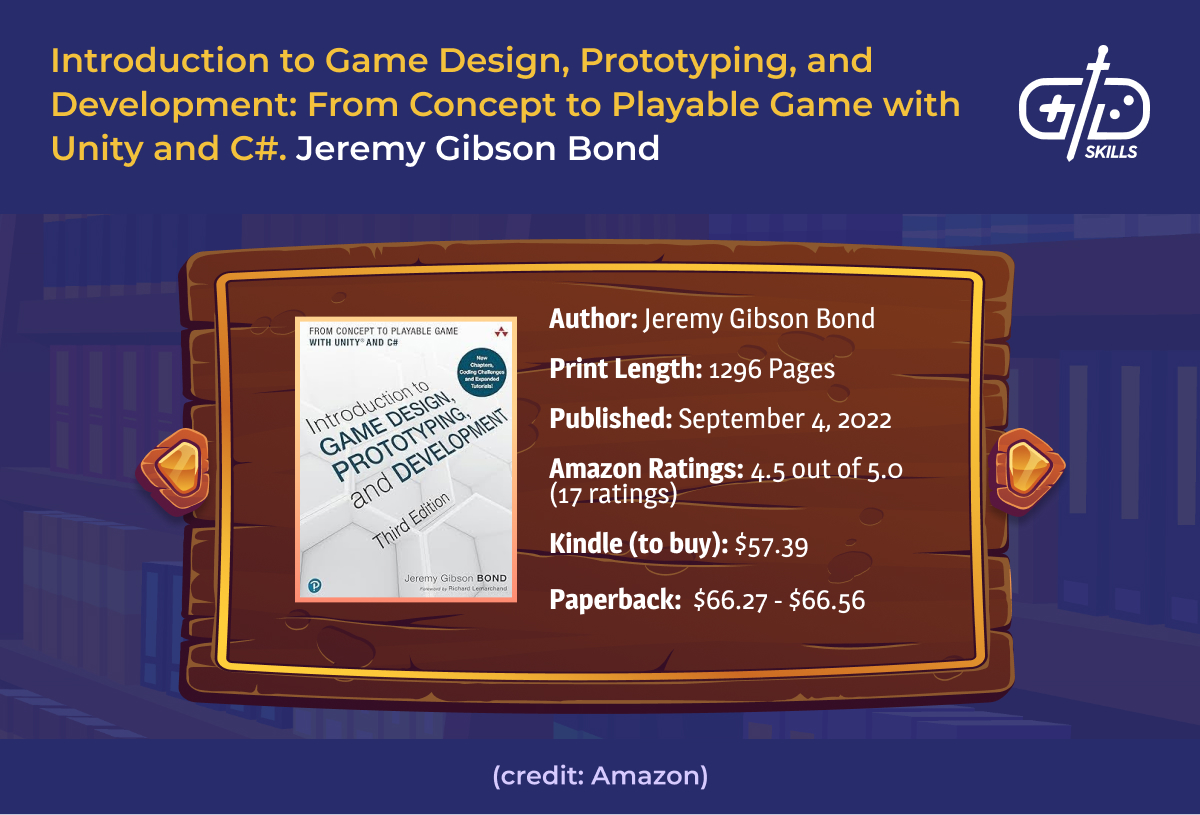
The instructional book covers topics to help game designers build a playable game, and among the topics are developing new game design concepts, creating working digital prototypes, improving designs through rapid iteration, playtesting games, feedback interpretation, tuning games, learning C#, and more. It transforms aspiring game designers into capable creators who can both conceptualize innovative games and turn them into tangible, playable prototypes.
15. Rules of Play: Game Design Fundamentals
Rules of Play: Game Design Fundamentals looks to create a theoretical framework and critical vocabulary for analyzing game design. Writers Katie Salen and Eric Zimmerman argue that as games become as important a cultural force as film or television, a comprehensive framework for analysis becomes important. Noted designers Salen and Zimmerman apply eighteen game design conceptual frameworks to establish a framework for the field of game design.
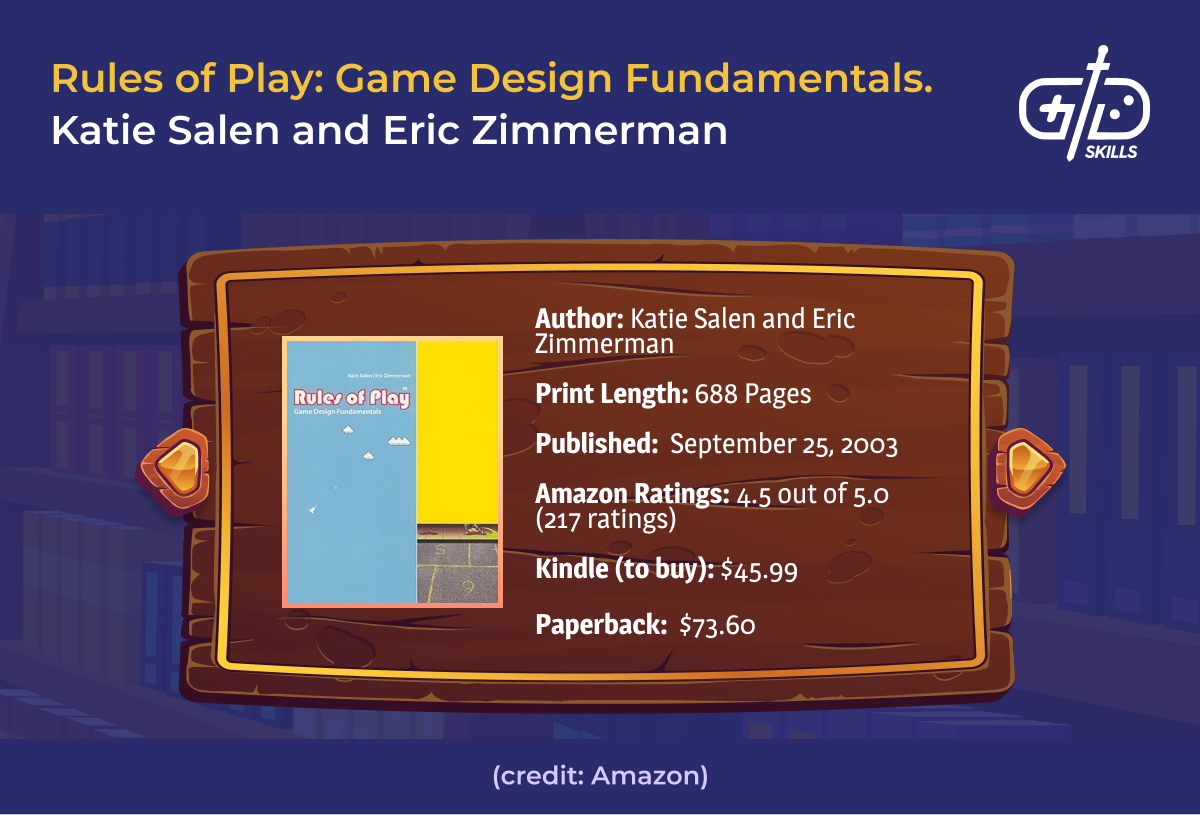
Rules of Play looks at board games and sports in addition to video games, attempting to build a unified model for understanding what drives play. The book is a reference point and theoretical guide and is intended for scholars, students, and designers who want a practitioner’s perspective on how to think about games at the deepest level. It introduces and defines core game principles such as “play”, “design”, and “interactivity” with a depth and nuance that goes beyond instructional information and into the philosophical.
16. 100 Principles of Game Design
100 Principles of Game Design looks at the meticulous planning and principles that underpin the players experience of spontaneous fun. Writer, consultant, and educator Wendy Despain looks at the themes of innovation, creation, balancing, and troubleshooting, and how they apply to the game design process. The book draws on psychology, architecture, and economics, showing how knowledge from each field applies to game design.
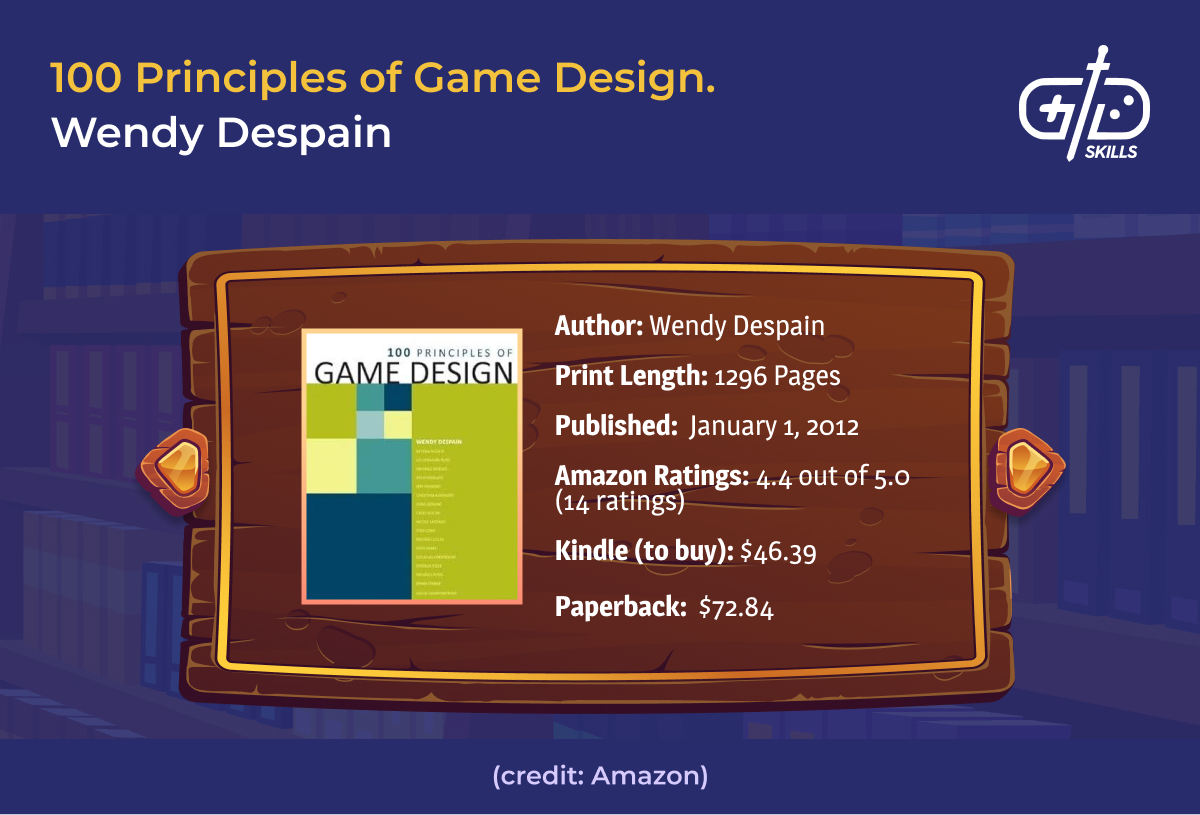
Each of the one hundred principles is accompanied by illustrations and photos explaining and expanding on explanations. Despain draws on her years of knowledge and insights from seasoned developers to create a reference point for new and veteran designers. 100 Rules features tips and insights on principles like feedback loops, game mechanics, prototyping, and more.
17. Level Up! The Guide to Great Video Game Design
Level Up! The Guide to Great Video Game Design opts for easy-to-understand terminology over industry jargon in its attempts to explain the design process. Writer Scott Rogers’ 30-year career in the game industry designing for games like God of War and Darksiders informs his insights into how to go from inspiration to production. The 3rd edition of the book features examples, illustrations, and new chapters.
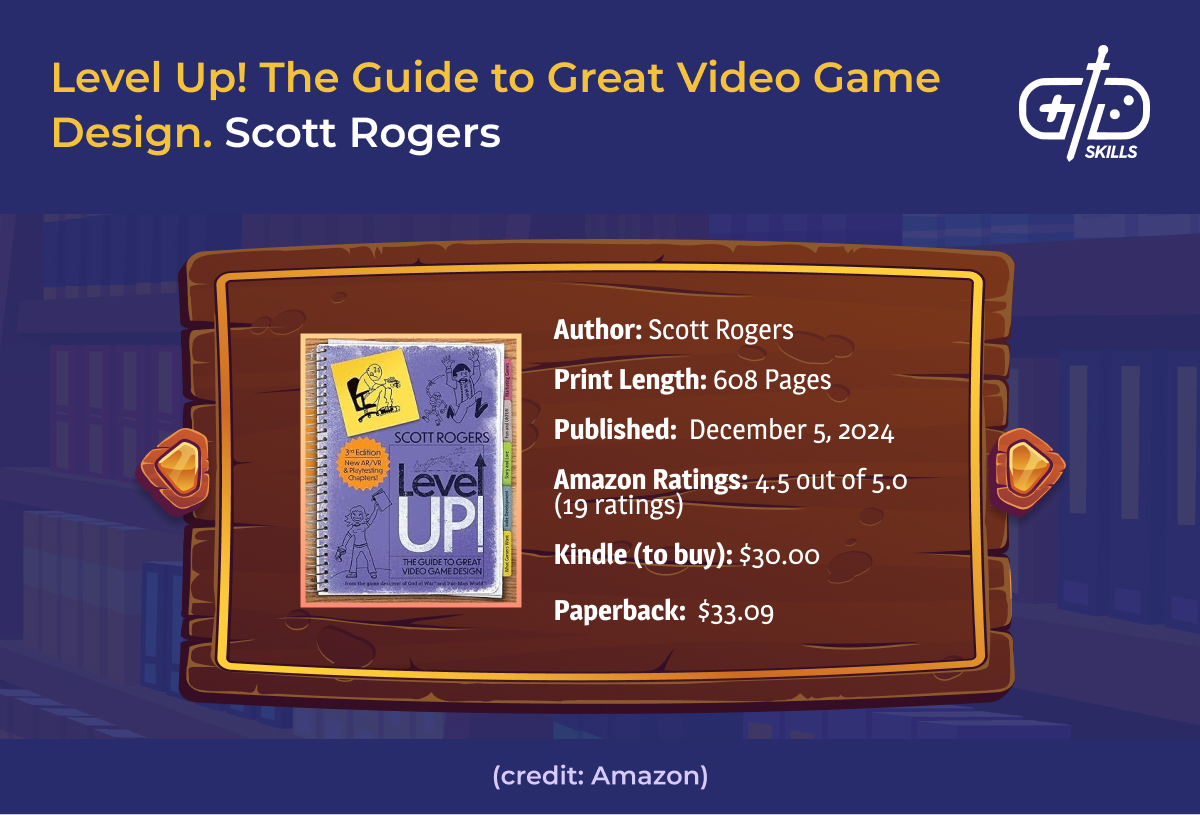
Level Up! The Guide to Great Video Game Design has remained a favorite of educators and students since its 2010 release. The book’s no-nonsense, layman’s approach to game design is an excellent jumping off point for those getting into game design, but also offers a fresh perspective to veteran designers or developers.
18. Fundamentals of Game Design
The Fundamentals of Game Design by freelance game designer, writer, and teacher Dr. Ernest Adams is a comprehensive textbook that provides a structured, analytical approach to understanding the core principles of game design. The book shows a first-hand look into the process of designing a game, from initial concept to final tuning.
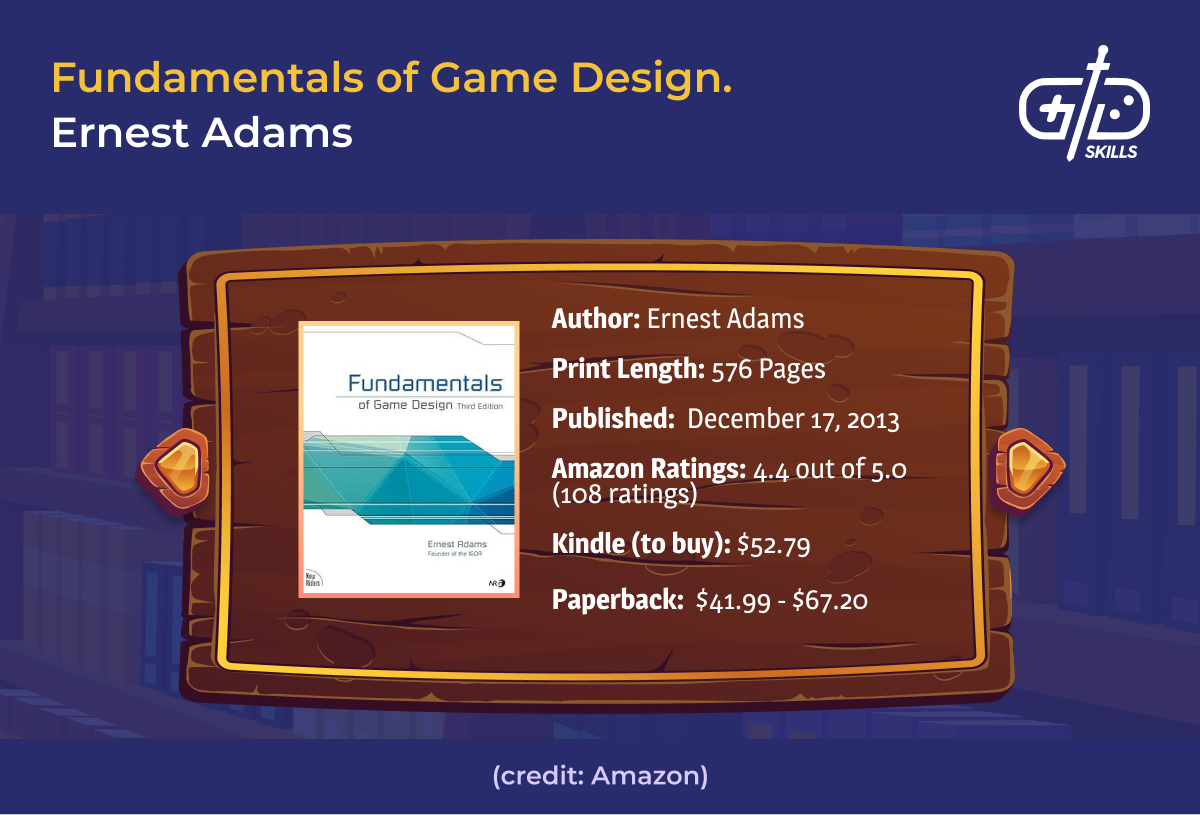
The book’s 3rd edition has been completely revised to include the latest developments in the game industry. Readers will learn about the fundamentals of concept development, gameplay design, core mechanics, user interfaces, storytelling, and balancing. The book also introduces designing for various platforms and teaches how the indie development scene burgeons and new business models are influencing game design in an easily digestible approach.
19. Video Game Storytelling: What Every Developer Needs to Know About Narrative Techniques
Video Game Storytelling: What Every Developer Needs to Know About Narrative Techniques is a book about game storytelling and has everything that every developer needs to know about narrative techniques. The book is authored by seasoned game industry veteran Evan Skolnick, who has worked on popular titles such as Star Wars: The Force Unleashed and Destroy All Humans!.
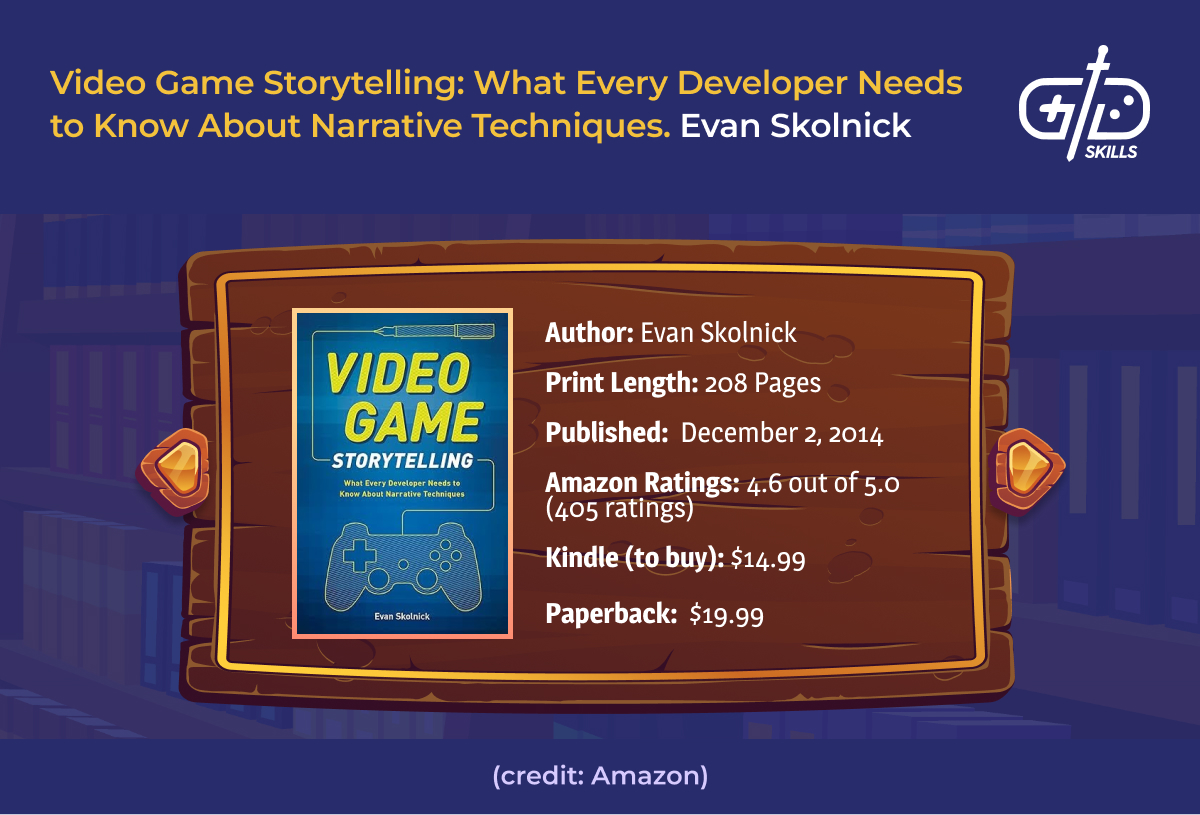
Video Game Storytelling provides a comprehensive yet easy-to-follow guide to storytelling basics and how they can be applied at every stage of the development process. The book teaches narrative creation techniques not only for writers but also to every member of the development team, so they can do their part in producing memorable and gripping narratives that enhance gameplay and captivate more players.
20. Start Your Video Game Career: Proven Advice on Jobs, Education, Interviews, and More for Starting and Succeeding in the Video Game Industry
Start Your Video Game Career: Proven Advice on Jobs, Education, Interviews, and More for Starting and Succeeding in the Video Game Industry is a complete book that teaches essential skills to start a video game development career with actionable advice and insider information.
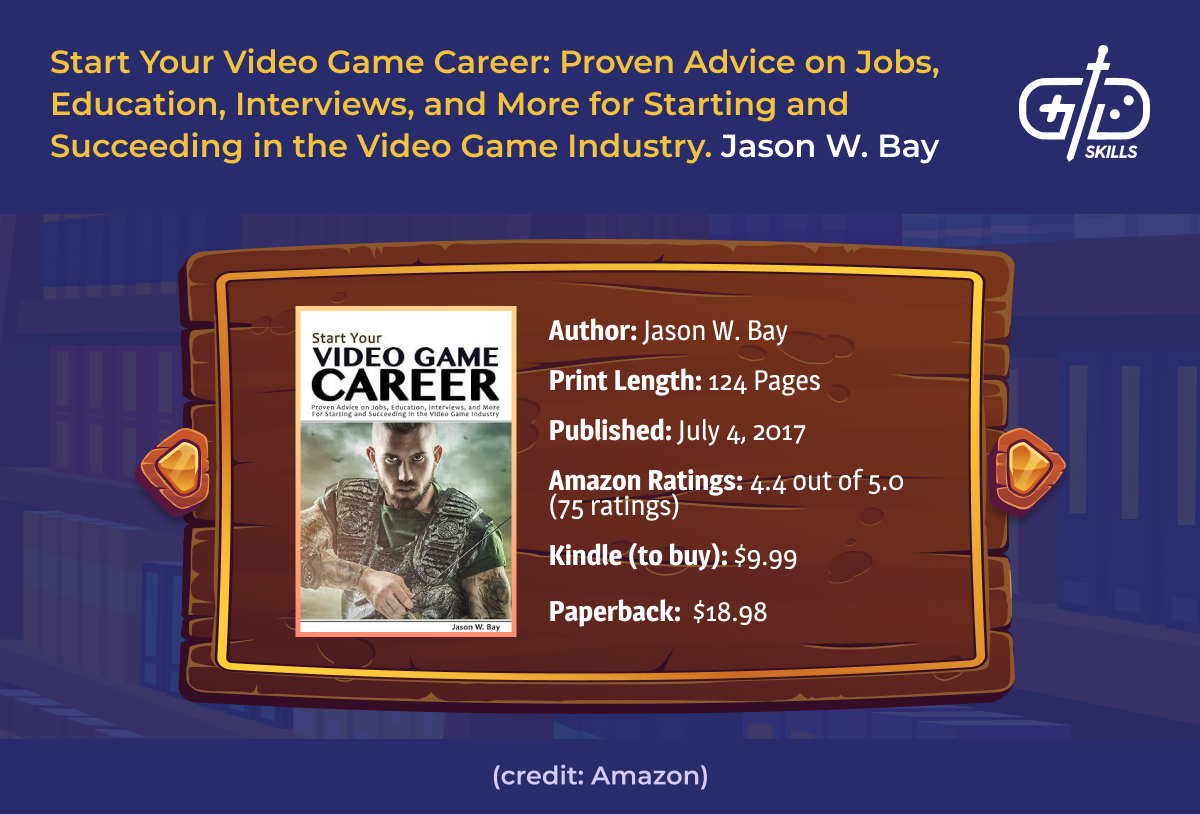
Industry expert Jason W. Bay guides readers in choosing a career, learning the skills, starting their job search, applying for jobs, acing interviews, and turning their first game job into a successful career. No matter the reader’s interest, this book has everything necessary to help launch a career in making games.
21. Designing Virtual Worlds book by Richard A. Bartle
Designing Virtual Worlds is the most comprehensive book about virtual design to date from one of the pioneers of online worlds, Richard A. Bartle, Ph.D. Bartle’s work is a must-have for game designers delving into the theory and practice of designing persistent online environments, especially for Massively Multiplayer Online (MMO) games and virtual worlds (VW).
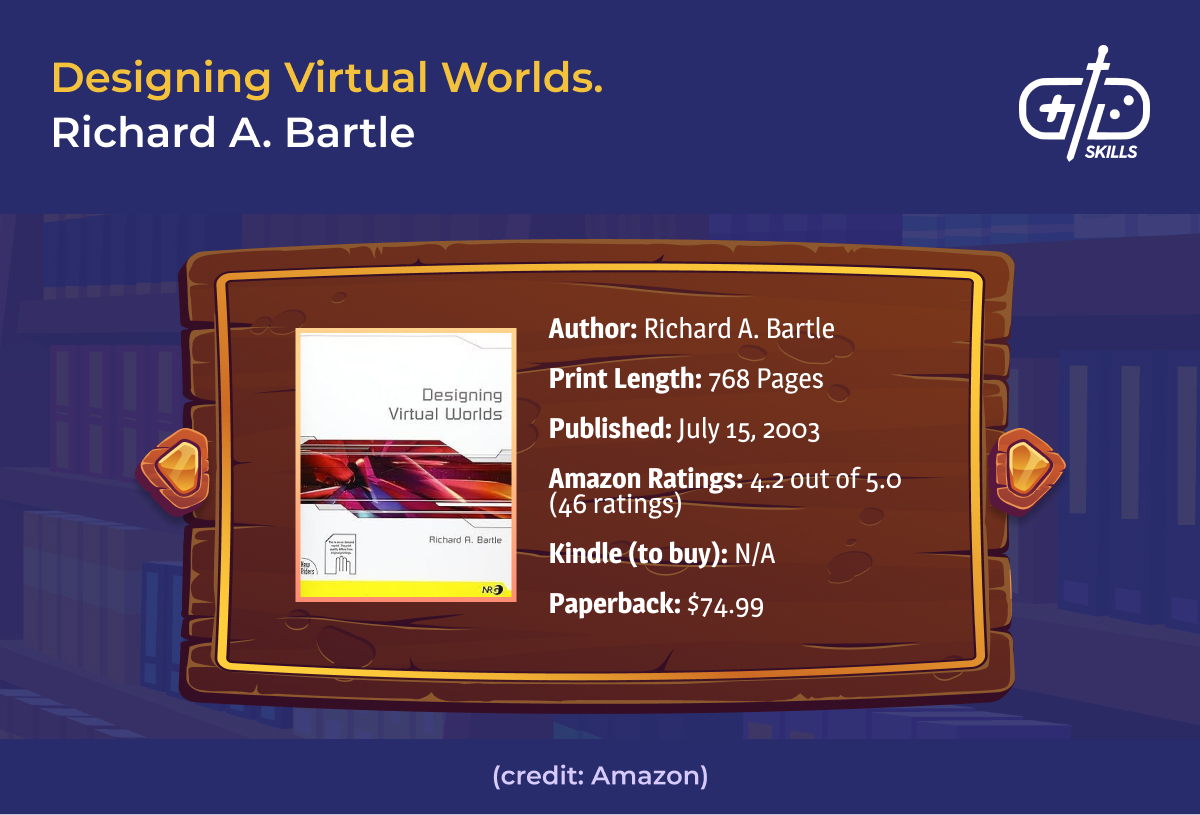
Bartle’s detailed 768-page book provides the reader with a deep understanding of VW design principles and also covers examples, from Multi-User Dungeons (MUDs) to MUD, Object Oriented (MOOs) to Massive Multiplayer Online Role-playing Games (MMORPGs), and text-based to graphical VWs. The book teaches the reader the actual, underlying design principles that many designers don’t understand when borrowing or building from previous games.
22. Game Mechanics: Advanced Game Design
Game Mechanics: Advanced Game Design emphasizes the importance of design and balance before writing a single line of code. The book aims to teach readers how to visualize, simulate, and prototype ideas with hands-on lessons and a downloadable simulation tool. Authors Ernest Adams and Joris Dormans look to codify ways of generating emergent gameplay instead of relying on scripted events.
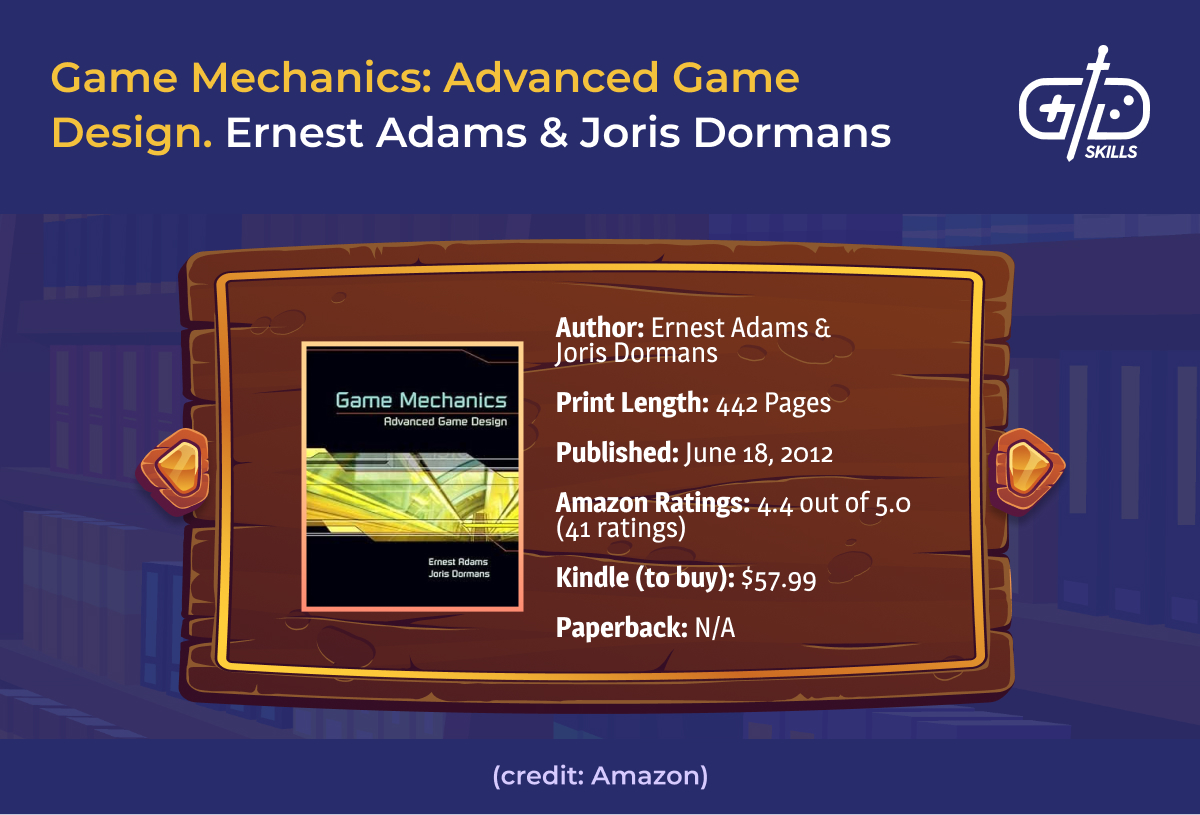
The book’s prototyping techniques allow designers to collect vast quantities of data from relatively short prototyping and playtesting sessions. The authors’ approach to explaining game design reveals the science behind decisions while paying respect to video games as an art form. It’s an excellent resource for designers interested in the intersection between game mechanics and level design.
23. Theory of Fun for Game Design
The Thoery of Fun for Game Design looks at the influence of traditional, pre-digital games on the field of video game design. Writer and veteran game designer Ralph Koster has worked on classic games like Star Wars: Galaxies and Ultima Online. He explores the concept of fun, what constitutes it, and how to use those ideas to create engaging games.
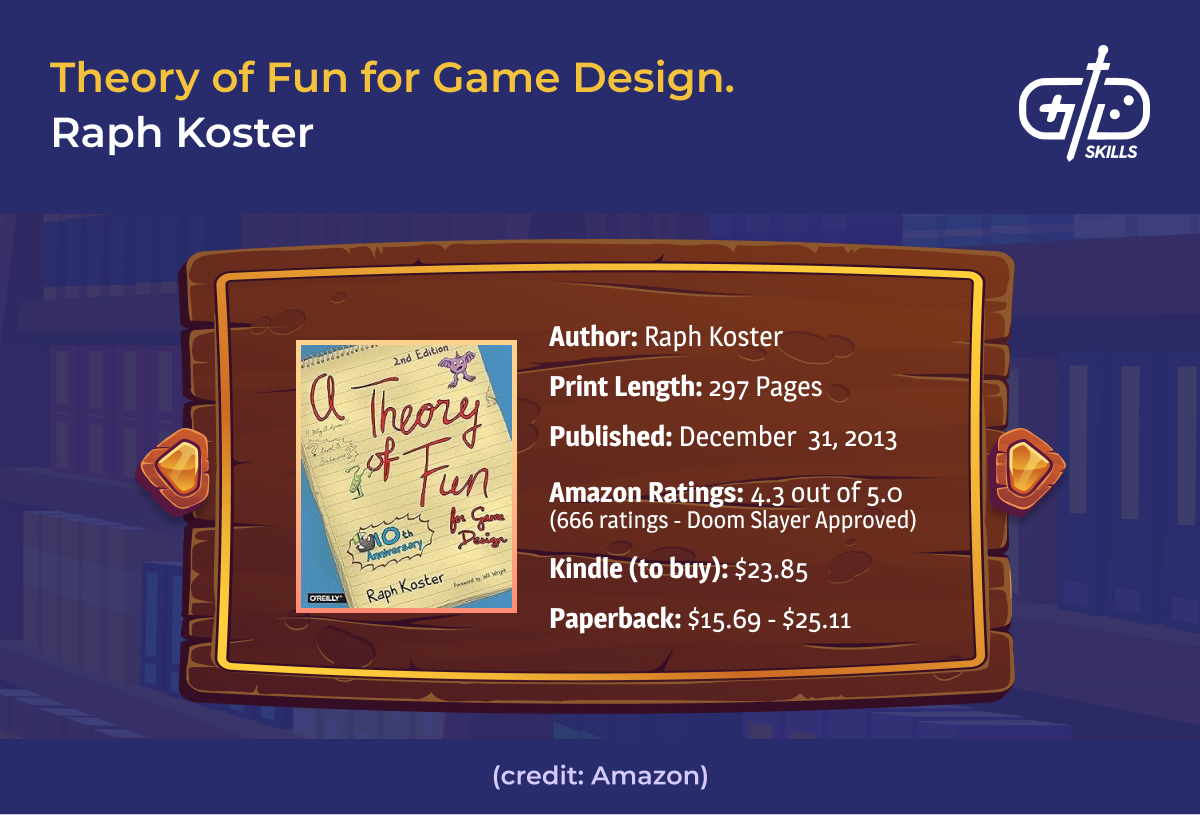
The book’s 2nd edition includes illustrated examples that demonstrate the deeper motivations behind why people engage in play. Gamers, designers, developers, or anybody interested in understanding why games have become such a dominant cultural force will find something worth reading here.
24. Think Like a Game Designer: The Step-by-Step Guide to Unlocking Your Creative Potential
Think Like a Game Designer: The Step-by-Step Guide to Unlocking Your Creative Potential offers simple, common sense tips on how to turn game ideas into reality. The book offers insights on the design process and on how to cultivate the mindset of a successful, goal-oriented game designer. Writer Justin Gary share his insights from working on games like Ascension and World of Warcraft Miniatures.
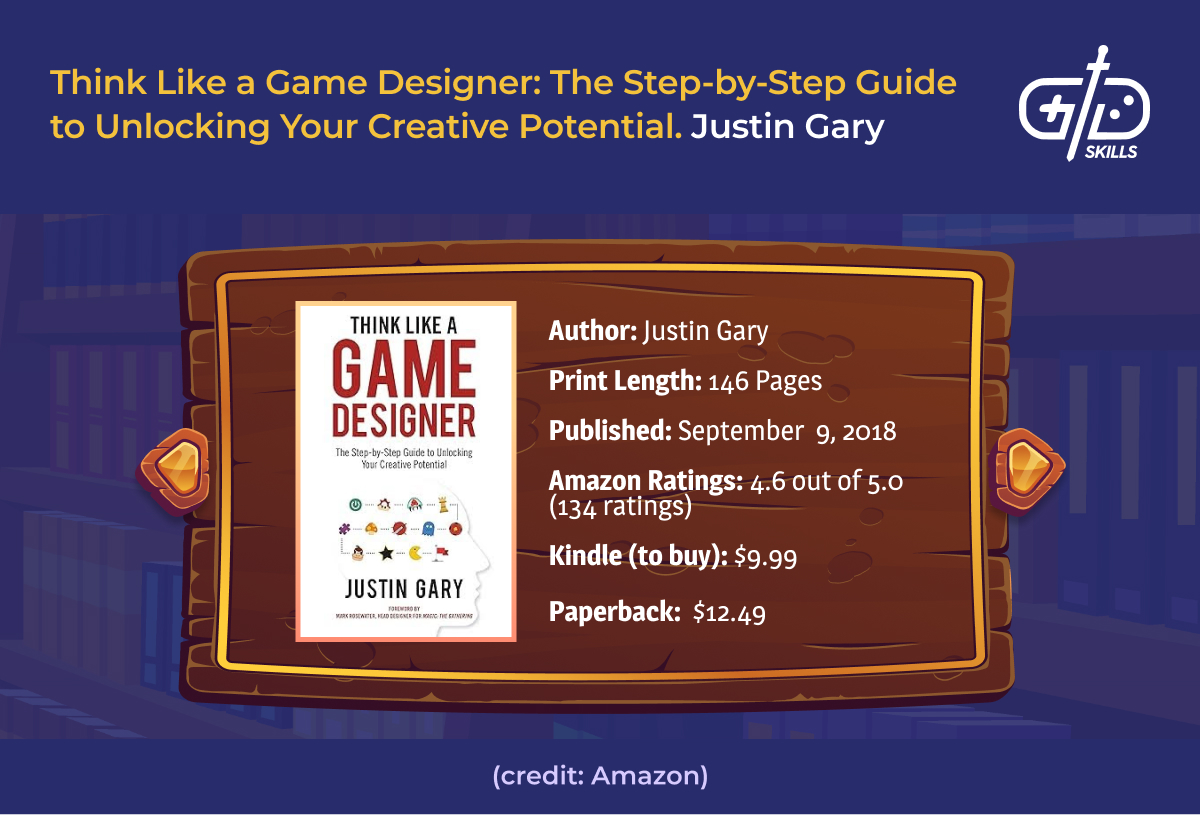
Think Like a Game Designer goes beyond theory and outlines a framework for brainstorming and refining ideas into pitchable concepts. Gary also includes insider tips on navigating the game industry and landing your first job. Practical exercise in each chapter work to reinforce the concepts taught. Think Like a Game Designer is an excellent starting point for a new designer who wants to move from ideation to execution.
How do books and online courses complement each other in learning game design?
Books and online courses complement each other in learning game design because books provide the structured, high-level overview, while online courses teach up-to-date, engine-specific skills training. Books act as a reference point for the theory that underpins games from ancient ones like chess and checkers to modern video games and their systems and mechanics. Online courses teach how to execute these high-level principles in a specific game engine like Unreal, Unity, or Godot.
Is it easier to follow a game design course after reading some foundational books?
Yes, it’s easier to follow a game design course after reading some foundational books. Books equip students with a theoretical framework and vocabulary that allows them to follow a structured course more easily. The initial learning curve of any game design course is significantly flattened by reading a well-reviewed game design book.


